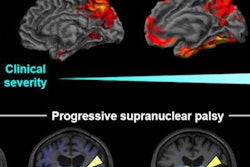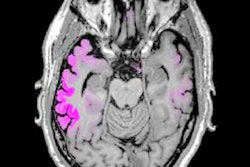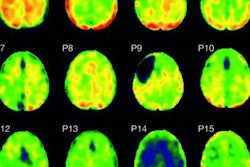
By binding to the tau protein associated with Alzheimer's, PET imaging with the tracer flortaucipir can distinguish between the disease and other neurodegenerative conditions with similar symptoms, according to an international study published in the September 18 issue of the Journal of the American Medical Association.
With greater tracer uptake in key regions of the brain, flortaucipir-PET achieved sensitivity and specificity of approximately 90% for detecting Alzheimer's disease versus other neurodegenerative diseases. The modality outperformed volumetric MRI measures as well.
"If we scan a patient with memory difficulties and he or she proves to have a lot of tau in the brain, we know with a high degree of certainty that it is a case of Alzheimer's," said senior researcher Rik Ossenkoppele, PhD, from Lund University in Sweden and VU University Medical Center in Amsterdam in a press release.
Avid Radiopharmaceuticals is currently developing flortaucipir (also known as F-18 AV-1451) for the early detection of neurodegeneration associated with Alzheimer's disease. The tracer is designed to bind to amyloid and tau-based neurofibrillary tangles, which are associated with Alzheimer's patients' progression to memory loss or physical deficiencies.
In the current study, the researchers analyzed 719 participants (mean age, 68.8 ± 9.2 years) from three dementia centers in South Korea, Sweden, and the U.S. between June 2014 and November 2017. Of the subjects, 254 had various non-Alzheimer's neurodegenerative disorders; 179 had Alzheimer's dementia; 126 had mild cognitive impairment, 66% of whom were positive for beta-amyloid plaque; and 160 were cognitively normal controls (JAMA, September 18, 2018, Vol. 320:11, pp. 1151-1162).
The researchers assessed flortaucipir's accuracy based on five key regions-of-interest (ROIs), using a standardized uptake value ratio (SUVR) threshold of 1.34 from the healthy controls and 1.27 for differentiating Alzheimer's dementia versus all non-Alzheimer's neurodegenerative disorders. They also compared the SUVR area under the curve (AUC) with volumetric MRI measurements of hippocampal volume, Alzheimer's signature, and whole-brain cortical thickness.
Ossenkoppele and colleagues found that flortaucipir uptake in the medial-basal and lateral temporal cortex achieved high accuracy at both SUVR thresholds for distinguishing between disorders.
| Accuracy of flortaucipir-PET | ||
| Measurement | SUV ratio of 1.34 | SUV ratio of 1.27 |
| Sensitivity | 89.9% | 96.8% |
| Specificity | 90.6% | 87.9% |
The AUCs for all five flortaucipir ROIs were significantly greater (AUC range: 0.92-0.95) than the three volumetric MRI measures (AUC range: 0.63-0.75) (p < 0.001). Diagnostic performance of the five flortaucipir ROIs were lower in those with mild cognitive impairment due to Alzheimer's disease (AUC range: 0.75-0.84).
"If you are found to have tau in the brain according to tau-PET, it is, with few exceptions, due to Alzheimer's disease," added study co-author Dr. Oskar Hansson, PhD, also from Lund University. "If you have normal tau-PET and mild to moderate dementia, your memory problems are most likely due to other neurological diseases."
While the technique performed well, "further research in clinically more representative populations is needed to understand its potential utility in patient care," the researchers concluded.



















